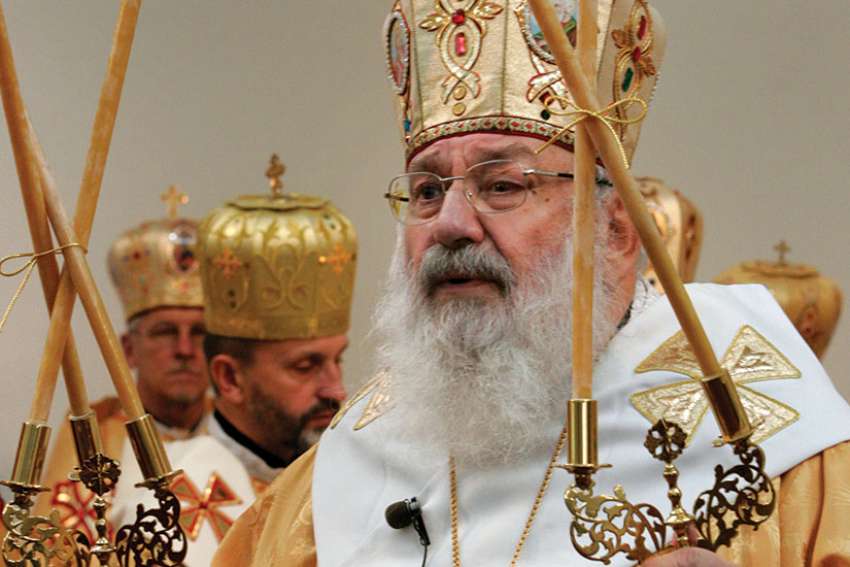Cardinal Husar led the resurrected UGCC; he became patriarch in 2001, 10 years after Ukraine threw off the shackles of Soviet slavery. During the 20th century, the UGCC was the largest underground Church in the world, its millions of members living under lethal Soviet persecution.
In 1939, the UGCC had some 3,000 priests in Ukraine. In 1989, after 50 years of war and persecution, the priesthood was reduced by 90 per cent, to just 300. At an average age of 70, the priesthood of the UGCC was just a generation away from extinction. Then came divine deliverance and the resurrection of a Church of martyrs. Nearly 30 years later, the UGCC has again 3,000 priests with an average age of 39. There are some 800 seminarians for five million Ukrainian Greek Catholics globally.
Husar belonged to both the entombment of the UGCC and its resurrection. Born in Lviv, his family escaped the advancing Red Army in 1944 and took refuge in the United States, where Lubomyr grew up, was ordained a priest and taught in the seminary. Called to Rome for further studies, he was subject to an extraordinary, secret ordination as a bishop.
In 1976, the head of the UGCC, Cardinal Josef Slipyj, living in exile in Rome after 18 years in the Soviet gulag, feared for the future of the UGCC. Would it have bishops to lead it, given that Slipyj himself was now over 80? So he ordained three bishops clandestinely, without the permission of the Holy Father, Blessed Paul VI. At the time, the Holy See followed a policy of non-assertiveness regarding the communist bloc; Paul VI would not give permission for the new bishops for fear of upsetting the Soviets.
The consecration of bishops without a papal mandate is a very grave canonical crime, for which the penalty is excommunication. Blessed Paul VI — who likely knew, unofficially, what Slipyj had done — did not administer any penalties.
Then came St. John Paul II, a bishop from the communist world who sought not only to upset the Soviet bloc, but to dismantle it. In time he would recognize Husar’s episcopal consecration as valid and return him to a free Ukraine for ministry.
About Cardinal Slipyj and the heroic resistance of the UGCC, St. John Paul II expressed himself in Canada. Cardinal Slipyj died on Sept. 7, 1984. The next week, while addressing the Ukrainian Catholic community in Winnipeg, John Paul spoke about the heroic shepherd.
“It is a joy to be with you today in the Metropolitan Cathedral of Saints Vladimir and Olga in Winnipeg,” John Paul said. “I am especially happy to be with you as we draw near to the solemn celebration of the first millennium of Christianity in the Ukraine (to be celebrated in 1988). Events of every time and place are directed by the loving plan of God, for God is the Lord of history.
In a special way God’s Providence has guided your development in Canada. The Archeparchy of Winnipeg, which is only the third Metropolitan See in the history of the Ukrainian people, was erected here in 1956.”
He continued: “Finding myself here with you, I cannot neglect to remember that great man, a confessor of the faith, major-archbishop, Cardinal Slipyj, whom God has called to eternity. In this difficult period for the Ukrainian Catholic Church, he was greatly tried by sufferings, but he did not fall; indeed, a hero, he resisted with great dignity.”
The resistance that Slipyj offered first in secret in the gulag, and then after his exile by strengthening Ukrainian Catholic institutions outside of Ukraine, laid the foundation for the Church’s revival. When that time came, Cardinal Husar was in place to lead it.
The life of Lubomyr Husar told the story of his people: from refugee in a displaced persons camp in Europe, to emigration to North America, to strengthening of the diaspora, to clandestine ordination in the Soviet period, to return to the homeland after liberation, to father of the nation.
In that story, the Ukrainian diaspora in Canada and the United States was essential, sustaining a Church that had officially disappeared in its native land. May his memory likewise be alive in the Ukrainian Catholic Church for years to come.
(Fr. de Souza is the editor-in-chief of Convivium.ca and a pastor in the Archdiocese of Kingston.)

